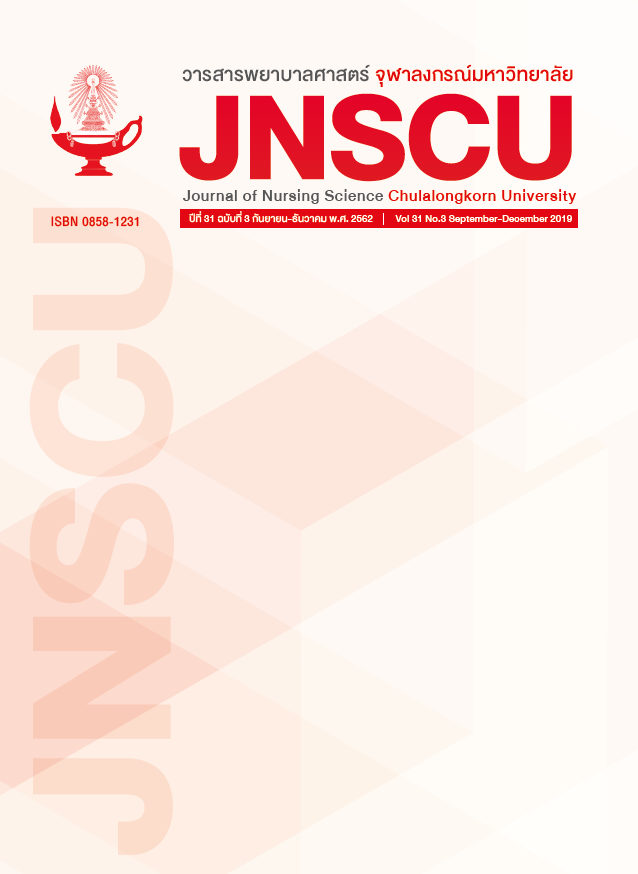การสร้างชุมชนต้นแบบเพื่อป้องกันและควบคุมโรคเบาหวานโดยชุมชนมีส่วนร่วม
คำสำคัญ:
ชุมชนต้นแบบ/โรคเบาหวาน/ชุมชนมีส่วนร่วมบทคัดย่อ
วัตถุประสงค์: เพื่อศึกษาการสร้างชุมชนต้นแบบในการป้องกันและควบคุมโรคเบาหวานโดยชุมชนมีส่วนร่วม
แบบแผนการวิจัย: การวิจัยเชิงปฏิบัติการแบบมีส่วนร่วม
วิธีดำเนินการวิจัย: ผู้ร่วมวิจัยคือประชาชนที่มีภาวะเสี่ยงเป็นโรคเบาหวานและครอบครัว เจ้าหน้าที่โรงพยาบาลส่งเสริมสุขภาพตำบล (รพสต.) ผู้นำชุมชน อาสาสมัครสาธารณสุขหมู่บ้าน (อสม.) พระสงฆ์ ครูและแม่ค้าขายอาหารจำนวน 814 คน เครื่องมือวิจัยประกอบด้วย: 1) แบบสัมภาษณ์เชิงลึก 2) แนวทางการสนทนากลุ่ม 3) แนวทางการประชุมระดมสมอง 4) แนวทางการสังเกต และ แบบบันทึกภาคสนาม วิเคราะห์ข้อมูลเชิงคุณภาพด้วยการวิเคราะห์เชิงเนื้อหา (Content analysis)
ผลการวิจัย: ภายหลังเข้าร่วมโครงการวิจัย กลุ่มเสี่ยงเป็นโรคเบาหวานมีการจัดการดูแลสุขภาพตนเองโดยการควบคุมอาหารและน้ำหนักตัว ออกกำลังกาย มีการจัดการความเครียดได้ ลดการดื่มเครื่องดื่มแอลกอฮอล์ ลดการสูบบุหรี่และไปตรวจคัดกรองโรคเบาหวานประจำปี โดยชุมชนดำเนินการให้คำแนะนำและส่งเสริมสุขภาพในประเด็นเหล่านี้ ปัญหาและอุปสรรคที่พบคือ การให้บริการตรวจคัดกรองเบาหวานที่ไม่ทั่วถึง ขาดสถานที่ ผู้นำ แรงจูงใจและความต่อเนื่องในการออกกำลังกาย
สรุป: รูปแบบชุมชนในการป้องกันและควบคุมโรคเบาหวานควรประกอบด้วย เจ้าหน้าที่ รพสต. ให้บริการตรวจสุขภาพ ผู้นำชุมชน ร่วมรับรู้ปัญหา สนับสนุนการแก้ปัญหา และเป็นแบบอย่างการดูแลสุขภาพ อสม. เฝ้าระวัง แจ้งข่าว ดูแลสุขภาพกลุ่มเสี่ยง
คำสำคัญ: ชุมชนต้นแบบ/โรคเบาหวาน/ชุมชนมีส่วนร่วม
เอกสารอ้างอิง
1. World Health Organization. Global report on diabetes. World Health Organization, 2016.
2. International Diabetes Federation. IDF Diabetes Atlas, 8 th ed. Brussels, Belgium: International Diabetes Federation, 2017.
3. American Diabetes Association.Classification and Diagnosis of Diabetes. Diabetes Care. 2017;40(Supplement 1):S11-S24; DOI:https://doi.org/10.2337/dc17-S005.
4. Miot A, Ragot S, Hammi W, et al. Prognostic value of resting heart rate on cardiovascular and
renal outcomes in type 2 diabetic patients: a competing risk analysis in a prospective cohort. Diabetes Care. 2012;35:2069–75;DOI: http:// dx.doi.org/10.2337/dc11-2468.
5. Yau JW, et al. Global prevalence and major risk factors of diabetic retinopathy. Diabetes care. 2012;35:556-564.
6. Chronic Kidney Disease Prevention Project in Hypertension and Diabetes Patients 2559. Nonthaburi, Thailand: Department of Disease Control, Ministry of Public Health, 2016.
7. Lima VC, et al. Risk factors for diabetic retinopathy: a case-control study. International journal of retina and vitreous. 2016;2:21.
8. Thai National Health Examination Survey V Study Group. Thai National Health Examination Survey, NHES V. Nonthaburi, Thailand: National Health Examination Survey Office, Health System Research Institute, 2016.
9. Chatterjee S, et al. Cost of diabetes and its complications in Thailand: a complete picture of
economic burden. Health Soc Care Community. 2011;19(3):289-98.
10. Zhang P, et al. Global healthcare expenditure on diabetes for 2010 and 2030. Diabetes
research and clinical practice. 2010;87:293-301.
11. National 5-Year NCD Disease Prevention and Control Strategy Plan for 2017- 2021. Bureau of Non-Communicable Diseases, Department of Disease Control, Ministry of Public Health. 2017.
12. Nakhamin K, Chomnirutana W, Limtragool P. Diabetes prevention strategies by community participation. Journal of nurses’ association of Thailand, North-Eastern Division. 2013; 31(1):43-51. (in Thai).
13. Kerdonfag P, Wongsunopparat B, Udomsubpayakul U, Nuntawan C. Perceived risk, criteria-based risk to Diabetes Mellitus, and health-promoting lifestyles in the first degree relatives of persons with Diabetes Mellitus. Rama Nurs J. 2010;16(2):169-84. (in Thai).
14. Suwattanakul T. Factors related to blood sugar control among Diabetes Mellitus type 2 patients. Journal of Health Systems Research. 2018;12(3):515-22. (in Thai).
15. Puttaruk U, Bumrerraj S. Factors related to control blood sugar among diabetes mellitus type 2 patients, treated at Kang Pla Health Promoting Hospital, Loei province. Community Health Development Quarterly Khon Kaen University. 2015;3(1):19-35. (in Thai)
16. Buraphunt R, Muangsom N. Factors affecting uncontrolled type 2 diabetes mellitus of patients in Sangkhom Hospi¬tal, Udonthani province. KKU Journal for Public Health Research. 2013;6(3):102-9. (in Thai)
17. Eticha T, AbrahaleyMulu HG, GetuKahsay DA, Rajeshwar Y. Factors associated with poor glycemic control in type 2 diabetic patients investigated at Ayder referral hospital, Mekelle, Ethiopia Ijppr. Human. 2016;6(3):160–71.
18. Kurnia DA, Amatayakul A, Karuncharernpanit S. Predictors of diabetes self-management
among type 2 diabetics in Indonesia: Application theory of the health promotion model. International Journal of Nursing Sciences. 2017;4(3):260-65.
19. Kurnia DA, Amatayakul A, Karuncharernpanit S. Diabetes self-management among adults with type 2 Diabetes Mellitus in Malang, Indonesia. International Journal of Tropical Medicine. 2017;12(2):25-28.
20. Sawangsri W, Intaranongpai S. The development of health promotion model for prevention new cases of Diabetes Mellitus in community. Journal of The Royal Thai Army Nurses. 2015; 16(1):116-22. (in Thai).
เผยแพร่แล้ว
ฉบับ
ประเภทบทความ
สัญญาอนุญาต
ลิขสิทธิ์ (c) 2020 วารสารพยาบาลศาสตร์ จุฬาลงกรณ์มหาวิทยาลัย

อนุญาตภายใต้เงื่อนไข Creative Commons Attribution-NonCommercial-NoDerivatives 4.0 International License.
ลิขสิทธิ์ของบทความที่ตีพิมพ์เป็นของวารสารพยาบาลศาสตร์ จุฬาลงกรณ์มหาวิทยาลัย ทั้งฉบับตีพิมพ์เป็นรูปเล่มและเอกสารออนไลน์



